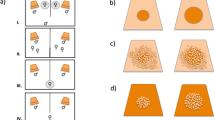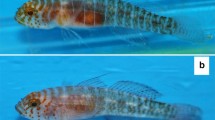Synopsis
This paper describes the reproductive behaviour of Aidablennius sphynx, which was studied in the field during four breeding seasons. Artificial nest sites were used for the determination of nest contents. The breeding season started at the end of April, when water temperature had just reached 14–15° C. The breeding season extended into August. Breeding males defended nests (crevices in the substrate), in which they cared for eggs laid by females. Female home ranges varied from narrow (about 10 m) to wide (about 45 m) stretches of shoreline. Females in narrow home ranges sometimes made excursions outside their home range. The number of males in nests that females could encounter was between 3 and 18. Individual males and females could have several sexual interactions per day with the same or different partners. Roughly 30% of the interactions led to nest entry by the female, and slightly less than 10% resulted in egg deposition by the female. Many different sequences of behaviour elements led to mating; for example male courtship display was not necessarily performed when mating resulted. Males defended the same nest and received eggs continuously throughout the breeding season; there were no nesting cycles. Broods contained up to 7000 eggs from different females in different stages of development. Males did not receive eggs every day. If any eggs were received on a day, the average number was 280, laid by one or more females. Females in aquaria laid on average 286 (range 1–897) eggs at intervals of on average 2.5 (range 1–13) days. This is probably a too high estimate of female egg production, since the fishes in the aquaria were well fed. In the discussion it is argued that detailed descriptions of the breeding biology of individual fish species are relevant to theoretical considerations of reproductive styles in fishes.
Similar content being viewed by others

References cited
Abel, E.F. 1964. Freiwasserstudien zur Fortpflanzungsethologie zweier Mittelmeerfische, lennius canevae Vinc. und Blennius inequalis C.V.Z. Tierpsychol. 21: 205–222.
Abel, E.F. 1980. Zur Fortpflanzungs-Ethologie des Mittelmeerschleimfisches Lipophrys dalmatinus (= Blennius dalmatinus Steind. et Kolomb.) im natürlichen Biotop. Verhandlungen der Zoologisch-Botanischen Gesellschaft in Österreich 118/119: 113–122.
Abel, E.R. Colouration phenomena of Mediterranean Blennies (Pisces, Benniidae). PSZNI, Marine Ecology 14 (4): 291–312.
Almada, V.C., R.F. de Oliveira, E.N. Barata, E.J. Gonçalves & A.P. Rito, 1990. Field observations on the behaviour of the breeding males of Lipophrys pholis (Pisces: Blenniidae). Portugaliae Zoologica 1: 27–36.
Almada, V.C., E.J. Gonçalves, R.F. Oliveira & A.J. Santos. 1995. Courting females: ecological constraints affect sex roles in a natural population of the blenniid fish Salaria pavo. Anim. Behav. 49: 1125–1127.
Baylis, J.R. 1981. The evolution of parental care in fishes, with reference to Darwin's rule of male sexual selection. Env. Biol. Fish. 6: 223–251.
Breder, C.M. & D.E. Rosen. 1966. Modes of reproduction in fishes. Natural History Press, Garden City. 941 pp.
Brown, L. 1981. Patterns of female choice in mottled sculpins (Cottidae, Teleostei). Anim. Behav. 29: 375–382.
Clutton-Brock, T.H. 1991. The evolution of parental care. Princeton University Press, Princeton. 352 pp.
DeMartini, E.E. 1987. Paternal defence, cannibalism and polygamy: factors influencing the reproductive success of painted greenling (Pisces, Hexagrammidae). Anim. Behav. 35: 1145–1158.
Downhower, J.F. & L. Brown. 1980. Mate preferences of female mottled sculpins, Cottus bairdi. Anim. Behav. 28: 728–734.
Fishelson, L. 1975. Observations on behaviour of the fish Meiacanthus nigrolineatus Smith-Vaniz (Blenniidae) in nature (Red Sea) and in captivity. Aust. J. Mar. Freshwat. Res. 26: 329–341.
Gibson, R.N. 1969. The biology and behaviour of littoral fish. Oceanogr. Mar. Biol. Ann. Rev. 7: 367–410.
Gibson R.N. 1993. Intertidal teleosts: life in a fluctuating environment. pp. 513–536. In: T.J. Pitcher (ed.) Behaviour of Teleost Fishes, 2nd edition, Chapman & Hall, London.
Goldschmidt, T., T.C.M. Bakker & E. Feuth-de Bruijn. 1993. Selective copying in mate choice of female sticklebacks. Anim. Behav. 45: 541–547.
Gross, M.R. & R.C. Sargent. 1985. The evolution of male and female parental care in fishes. Amer. Zool. 25: 807–822.
Guitel, F 1893. Observations sur les moeurs de trois blenniidés, Clinus argentatus, Blennius montagui, et Blennius sphynx. Arch. de Zool. Exp. et Gen. 3: 325–384.
Hastings, P.A. 1988. Female choice and male reproductive success in the angel blenny, Coralliozetus angelica (Teleostei: Chaenopsidae). Anim. Behav. 36: 115–124.
Heymer, A. 1987. Comportement agonistique, stratégies reproductrice et investissement parentel chez Blennius basiliscus (Teleostei, Blenniidae). Revue Française d'Aquariologie 14: 89–108.
Heymer, A. & C.A. de Ferret. 1976. Zur Ethologie des Mittelmeer-Schleimfisches Blennius rouxi Cocco, 1833. Z. Tierpsychol. 41: 121–141.
Hunter, J.R. 1963. The reproductive behaviour of the green sunfish, Lepomis cyanellus. Zoologica 48: 13–24.
Iersel, J.J.A. van. 1953. Analysis of parental behaviour of the male three-spined stickleback (Gasterosteus aculeatus L.). Behaviour, suppl. 3. 159 pp.
Illich, I.P. & K. Kotrschal. 1990. Depth distribution and abundance of northern Adriatic littoral rocky reef blennioid fishes (Blenniidae and Tripterygion). PSZNI, Marine Ecology 11 (4): 277–289.
Knapp, R.A. & R.R. Warner. 1991. Male parental care and female choice in the bicolor damselfish, Stegastes partitus: bigger is not always better. Anim. Behav. 41: 747–756.
Kraak, S.B.M. 1996. Female preference and filial cannibalism in Aidablennius sphynx (Teleostei, Blenniidae): a combined field and laboratory study. Behavioural Processes 36: 85–98.
Kraak, S.B.M. & E.P. van den Berghe. 1992. Do females assess paternal quality by means of test eggs? Anim. Behav. 43: 865–867.
Kraak, S.B.M. & J.J. Videler. 1991. Mate choice in Aidablennius sphynx (Teleostei, Blenniidae): females prefer nests containing more eggs. Behaviour 119: 243–266.
Marconato, A. 1985. Reproductive behaviour and mate choice in Cottus gobio (Pisces, Cottidae). Monit. Zool. Ital. NS 19: 60–61.
Petersen, C.W. 1989. Females prefer mated males in the carmine triplefin Axoclinus carminalis (Pisces: Tripterygiidae). Env. Biol. Fish. 26: 213–221.
Petersen, C.W. 1990. The occurrence and dynamics of clutch loss and filial cannibalism in two Caribbean damselfishes. J. Exp. Mar. Biol. Ecol. 135: 117–133.
Petersen, C.W. & K. Marchetti. 1989. Filial cannibalism in the cortez damselfish Stegastes rectifraenum. Evolution 43: 158–168.
Phillips, R.R. 1977. Behavioral field study of the Hawaiian rockskipper, Istiblennius zebra (Teleostei, Blenniidae). I. Ethogram. Z. Tierpsychol. 43: 1–22.
Potts, G.W. & R.J. Woottontrategies and tactics. Academic Press, London. 410 pp.
Quasim, S.Z. 1956. The spawning habits and embryonic development of the shanny (Blennius pholis L.). Proc. Zool. Soc. London 127: 79–93.
Rohwer, S. 1978. Parent cannibalism of offspring and egg raiding as a courtship strategy. Amer. Nat. 112: 429–440.
Santos, R.S. & J.P. Barreiros. 1993. The ethogram of Parablennius sanguinolentus parvicornis (Pisces: Blenniidae) of the Azores Arquipélago. Life and Marine Sciences 11A: 73–90.
Sargent, R.C. 1988. Paternal care and egg survival both increase with clutch size in the fathead minnow, Pimephales promelas. Behav. Ecol. Sociobiol. 23: 33–37.
Sargent, R.C. 1992. Ecology of filial cannibalism in fish: theoretical perspectives. pp. 39–62. In: M.A. Elgar & B.J. Crespi (ed.) Canibalism: Ecology and Evolution Among Diverse Taxa, Oxford University Press, Oxford.
Sargent, R.C., P.H. Crowley, C. Huang, M. Lauer, D. Neergaard & L. Schmoetzer. 1995. A dynamic program for male parental care in fishes: brood cycling and filial cannibalism. Behaviour 132: 1059–1078.
Sargent, R.C. & M.R. Gross. 1993. Williams' principle: an explanation of parental care in the teleost fishes. pp. 333–361. In: T.J. Pitcher (ed.) Behaviour of Teleost Fishes, 2nd edition, Chapman & Hall, London.
Sikkel, P.C. 1989. Egg presence and developmental stage influence spawning site choice by female garibaldi. Anim. Behav. 38: 447–456.
Sikkel, P.C. 1994a. Why female garibaldi prefer males with young eggs: a test of the parental investment hypothesis. Ethol. Ecol. Evol. 6: 191–211.
Sikkel, P.C. 1994b. Filial cannibalism in a paternal-caring marine fish: the influence of egg developmental stage and position in the nest. Anim. Behav. 47: 1149–1158.
Stephens, J.S., E.S. Hobson & R.J. Johnson. 1966. Notes on distribution behaviour and morphological variation in some Chaenopsid fishes from the tropical eastern Pacific, with descriptions of two new species. Acanthemblemaria castroi and Corralliozetus springer. Copeia 1966: 424–438.
Van den Berghe, E.P, F. Wernerus & R.R. Warner. 1989. Female choice and the mating cost of peripheral males. Anim. Behav. 38: 875–884.
Zander, C.D. 1972. Beitrage zur Ökologie und Biologie von Blenniidae (Pisces) des Mittelmeers. Helgoländer wiss. Meeresunters. 23: 193–231.
Zander, C.D. 1986. Blenniidae. pp. 1096–1112. In: P.J.P. Whitehead et al. (ed.) Fishes of the North-eastern Atlantic and the Mediterranean, vol. III, UNESCO, Paris.
Author information
Authors and Affiliations
Rights and permissions
About this article
Cite this article
Kraak, S.B.M. A quantitative description of the reproductive biology of the Mediterranean blenny Aidablennius sphynx (Teleostei, Blenniidae) in its natural habitat. Environ Biol Fish 46, 329–342 (1996). https://doi.org/10.1007/BF00005010
Received:
Accepted:
Issue Date:
DOI: https://doi.org/10.1007/BF00005010



